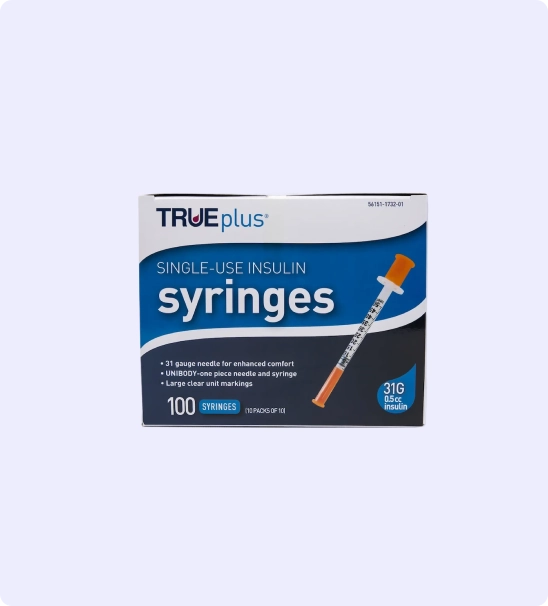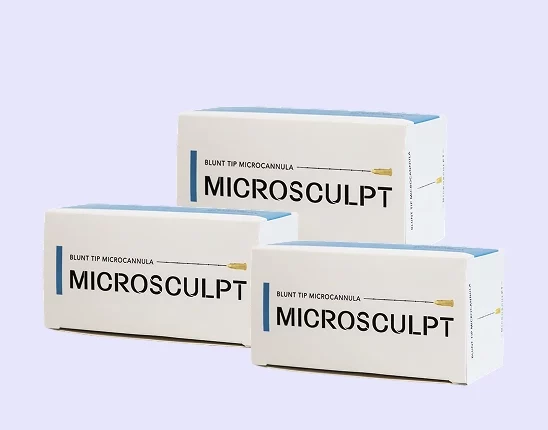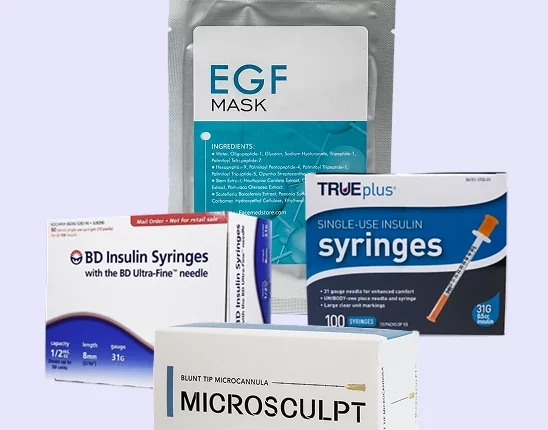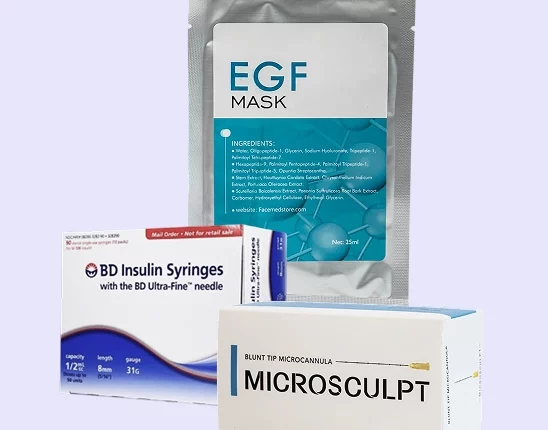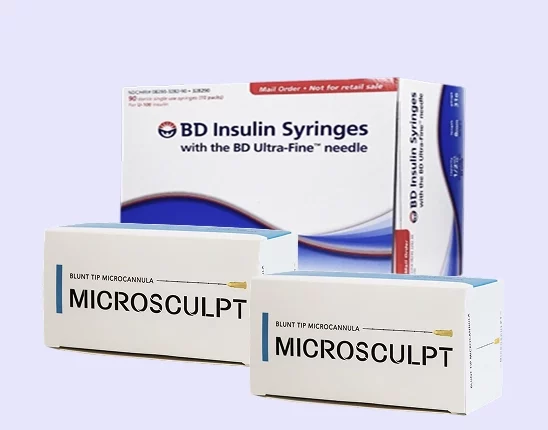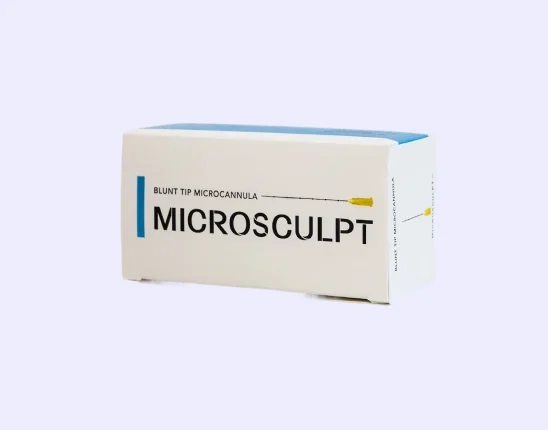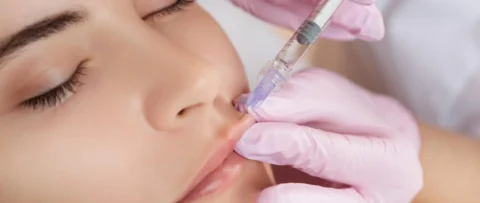Aspirations have been a long-taught safety procedure at hospitals that are used in intramuscular or subcutaneous injections to ensure that no major arteries are in the injection site. It’s an excellent precaution to take if the surgeon isn’t certain about their skills with the needle, or if some other difficulty arises with determining the patient’s facial anatomy.
But do you need to aspirate when using a cannula? No, since the design of the blunt-tip cannula isn’t favorable for aspiration. In addition, the design of the cannula directly addresses the concerns that aspiration seeks to address.
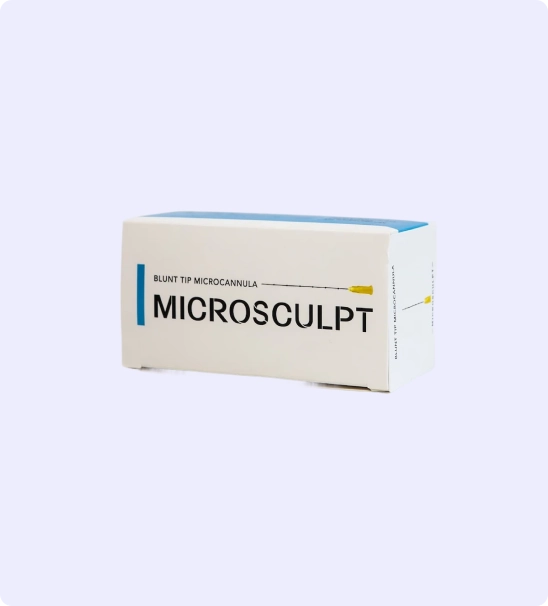
Injections Your Patients Will Love! Code “20OFF” Takes 20% off Your First Order!
Microcannulas are a tool that every great injector must master. Patients want quick results with no downtime. Our microcannulas are high quality and a fraction of the price of our competitors!
You can create an account here.
How Cannulas Interact With Aspiration
Blunt-tip cannulas are somewhat identical to traditional sharp-tip hypodermic needles, except they have a rounded tip and a flexible shaft. They’re also longer than the average hypodermic needle and are tailor made for subcutaneous injections. They can either inject material or extract it from the body, though the latter process is only used in some types of liposuction.
The primary advantage of using a cannula is that the blunt tip pushes its way into the skin. Sharp-tip needles pierce through any skin layer, which makes it more likely to puncture a major artery or a cluster of blood vessels. The relatively longer reach of the cannula also allows it to reach multiple injection sites from one point of entry, reducing the amount of trauma to the skin.
Since aspiration checks for punctured arteries by drawing back the syringe to check for blood, the blunt tip of the cannula makes this procedure irrelevant. Forcing aspiration while using a cannula will most likely result in more trauma to the injection site, more pain for the patient, and an overall increase of difficulty with the procedure.
This is especially crucial if the cannula is being used to inject dermal fillers, since the multiple injection sites required mean that the dermal filler may settle in the syringe during extraction, making injection more difficult. Since dermal fillers are usually injected in minute doses, aspiration just adds an unnecessary step and increases the risk of bruising or bleeding for the patient.
Why Use Cannulas With Dermal Fillers
Blunt-tip cannulas and microcannulas have seen an increase in use for injecting dermal filler, primarily because of the ease of their application and the versatile handling they can provide to injectors. However, it’s important to remember that not all dermal fillers – or even cosmetic injectables in general – show more success with cannula use. Botox is one of the best examples of this case.
However, cannulas afford several advantages to the surgeon, including but not limited to:
- More control over the filler material as it flows down the needle
- Fewer injection sites needed
- The capability to reach more sensitive areas from adjacent areas without making new entry points
- Flexible application of fillers to filler sites, especially grooves and lines like tear troughs
- More comfortable for the patient
- Reduces postoperative recovery time
- Decreases the risk of bleeding or bruising
Many dermal fillers like Restylane, Sculptra, and Juvederm can be used with cannulas or sharp-tip needles, giving the surgeon more leeway with deciding which injection method will work best for their patient.
Why Aspiration Before Injection Can Be A Problem
The practice of aspiration itself has been a point of concern for many doctors and dermatologists over the past few years. While aspiration has been practiced in the early days of intramuscular and subcutaneous injections, recent innovations like the blunt-tip cannula, injection results, and patient feedback have shown several problems with aspiration.
1. Movement and injection sites
Because the skin and muscles constantly shift even with the slightest movement, it can be tricky to determine if the injection site will not change even after the needle has already penetrated the skin layer. This can be even more complicated when the patient has plenty of skin or fat that the injector needs to sift through, since subcutaneous injections can be moved if the attending injector has not secured the needle to the site.
This is particularly crucial because patients will sometimes move or shift involuntarily during the injection procedure. They may react to the pain, react because of nervousness about the treatment, or be distracted by other factors in the environment. This is true even if topical anesthesia is used, since the patients aren’t stopped from moving unless the area has restraints.
Since sharp-tip needles don’t discriminate between subdermal layers and blood vessels, it could be possible that the injector may have punctured an artery and shifted the needle to move away from the puncture site during aspiration. While this can reduce the likelihood of injecting any foreign material directly into the bloodstream, this increases the chances of the patient experiencing bruising or bleeding post-procedure.
2. The relatively small diameter of sharp-tip needles giving a false positive
For dermal fillers and other similar injectables, the gauge or diameter of a hypodermic needle needs to be small to reduce any trauma to the skin and have better control over the rate of the filler injection. This small diameter performs well with injection but may present some serious issues with aspiration.
Because of the small diameter, aspiration may draw no blood at all, even if it hits a major artery. The gauge used for extracting blood and inserting filler materials are different, and an unskilled injector may see the lack of blood in the syringe as a false positive. This can be extremely dangerous to the patient, as the odds of any injectable material being inserted directly into their major arteries can cause arterial embolism or a stuck clot in their artery.
Even with the larger diameter needed for injecting some types of dermal fillers, the diameter may still be too small to properly extract blood if an artery is hit. Considering the amount of force and pressure required to aspirate, the injector also risks collapsing the blood vessel the needle tip punctured.
3. Surgeon skill in handling the syringe
Aspiration requires precise handling of the syringe, particularly the speed at which the doctor pulls back and whether the syringe is primed properly. While the assumption is that the injector would have enough skill in injections to make these concerns moot, there is always the chance that another outside factor can affect the success of the procedure.
The skill with handling needles can also be a crucial issue if the patient is getting a dermal filler since most of these procedures are done at cosmetic practices, not medical clinics. Though both locations and their staff share similar skill sets and tools, the knowledge to aspirate properly – and detect the signs of success or failure – may not be as ingrained with cosmetic estheticians.
Finally, the quality of the syringe itself can be substandard, especially if the needles have been switched between different aspirations. Because needles need to be replaced if the injector has aspired into a blood vessel, the syringe may not work as properly as it did for the first aspiration.
4. The viscosity of the dermal filler
The rheology of dermal fillers is a relatively understudied field, so many of them can be potential aspiration hazards. Because of the chemical composition and the overall flow rate of most dermal fillers, aspiration may present considerable risks and hazards when used with cosmetic treatments.
Dermal filler viscosity will vary across brands, injection sites, and active ingredients. This increases the risk of complications occurring if the injector is handling a dermal filler they have little experience with. While these complications may be avoided by a thorough understanding of the rheology of the dermal filler, aspiration just puts an extra step that the injector has to worry about.
5. Familiarity with the facial anatomy of the patient
Finally, the surgeon or dermatologist needs to have an in-depth understanding of the facial anatomy of the patient, or a good grasp of the anatomy of the injection site. If the injector isn’t too familiar with the areas to avoid, they risk performing multiple aspirations to find a suitable injection site. Aside from causing more trauma to the patient’s skin, this can also result in significant blood loss, and may cause the patient to be hospitalized for serious injuries.
This is even more critical if one considers that most dermal filler treatments are spread between two to three sessions, depending on the exact filler used. Repeated aspirations will cause longer postoperative care and recovery for the patient. While these delays will not affect the results from the filler treatments, it may significantly affect the patient’s quality of life.
There is also the possibility that the injector can be lulled into a false sense of complacency between filler treatments and fail to check their patient’s anatomy thoroughly before the aspiration. This can cause complications during and after the procedure, and may irreparably damage the confidence the patient has with their doctor.
6. Patient experience
All these complications also consider the relative experience of the patient with injections that aspirate. Most doctors and dermatologists report relatively negative impressions from their patients about aspirations, with some of them citing increased pain as the most common effect of performing them.
Because patients can be conscious during aspiration procedures, repeated aspirations may cause an aversion to the procedure in general. This can be a problem for both medical and cosmetic treatments that require consistent treatments over time, since the patient cannot keep up with the schedule and severely affect the results from their initial appointments.
While doctors can counsel their patients on the necessities of the procedure, it will ultimately fall to their own pain tolerance and comfort with aspiration. If the patient expresses discomfort and pain with aspiration, it can lead to a negative outlook on the entire treatment itself.
Many of these complications have led to injectors passing on aspirations entirely, for fear of complications or patient objections.
Should Hospitals And Cosmetic Practices Stop Aspiration?
Given these drawbacks, there are still situations where surgeons should aspirate, like non-surgical rhinoplasties, or injections in dorsogluteal sites. A survey of different clinicians shows that 65% of injectors aspirate, just not with every procedure.
Alternatively, injectors may also ask their patients about their comfort with the procedure. While most patients may reject aspiration of any form, some may choose to undergo the procedure for safety’s sake. Fortunately, aspiration can be stopped once the patient has better confidence in their injector or more experience with filler treatments.
However, the design of the blunt-tip cannula avoids the usual problems that necessitate aspiration. If the dermatologist is using a cannula to apply dermal fillers, they may skip the aspiration even if the injection is at an intramuscular layer.
Blunt-tip cannulas can also render aspiration irrelevant by their capacity to reach multiple injection sites with a single entry point, which reduces the likelihood of hitting major arteries. Because of their flexible needle design. Dermatologists can apply filler material without worrying about excessive trauma to sensitive skin.
Buy Quality Medical Tools And Supplies From FACE Medical Supply
-
 Microcannula Multi-Gauge Precision Set
Microcannula Multi-Gauge Precision Set -
 Microcannula Complete Injection System
Microcannula Complete Injection System -
 Microcannula Size Progression Training Kit
Microcannula Size Progression Training Kit -
 Microcannula Professional Starter Kit
Microcannula Professional Starter Kit -
 Microcannula Volume Practice Pack
Microcannula Volume Practice Pack -
 23 gauge 50 mm (2 inch) Microcannulas
23 gauge 50 mm (2 inch) Microcannulas -
 22 Gauge 100 mm (4 inch) Microcannulas.
22 Gauge 100 mm (4 inch) Microcannulas. -
 27 Gauge 38 mm (1.5 inch) Microcannulas
27 Gauge 38 mm (1.5 inch) Microcannulas -
 25 Gauge 38 mm (1.5 inch) Microcannulas
25 Gauge 38 mm (1.5 inch) Microcannulas
Due to the overall design of the blunt-tip cannula, aspiration is unnecessary after injection. If any aspiration is needed, dermatologists should use a sharp-tip needle for the best results, though it’s crucial to keep in mind that the benefits of aspiration are not the same across the board. In addition, the efficacy of aspiration will also rely on their knowledge of their patient’s anatomy and their skill with using a needle.
FACE Medical Supply is a leading supplier of quality medical tools and supplies like cannulas and syringes to cosmetic practices in New York. We specialize in providing a comprehensive catalog of medical equipment and other aesthetic products at competitive prices and pride ourselves on excellent customer service.
Contact us today to find out more about our supplies.
Learn more: Collagen VS Biotin For Hair Growth
